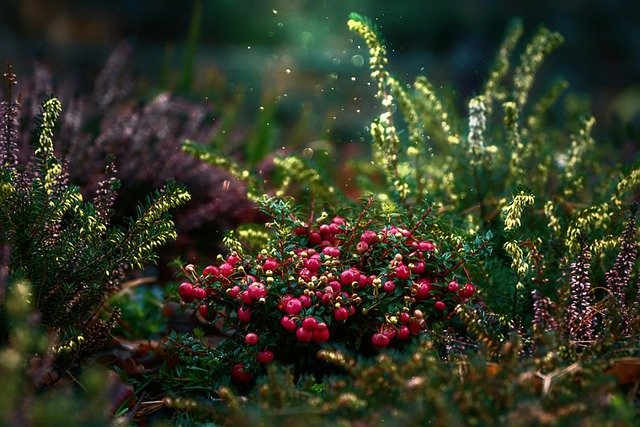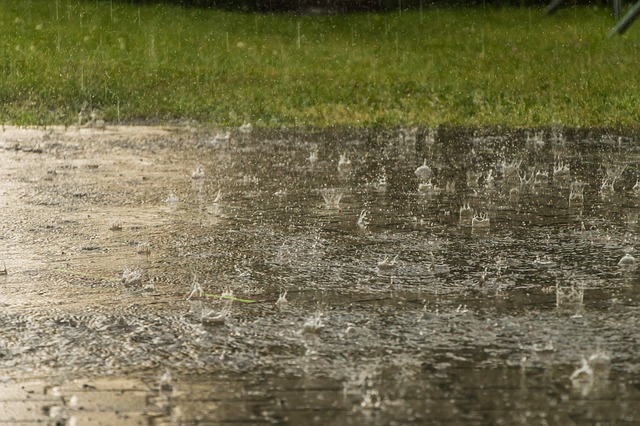you can honestly locate your hummingbird feeders can anywhere provided you take precautionary measures that won’t put the birds in harms way because the birds getting hurt is still very much a possibility.
Ideally you’d want to place the feeders around 5ft in the air so cats, mice and other don’t just take over the food source, either 3 – 5 feet or 30ft+ away from your home where being closer limits collisions with your window as a result of the slower take off whilst being further from your home allows the hummingbirds enough room to clear it.
Lastly, placing them between shrubs, trees, and bushes is better too as it acts as an extra form of protection if predators were to be near the feeders.
Throughout the rest of this article we’ll be going over the elements mentioned above in more detail so you’ll understand how to provide the best feeder experience for these tiny feathered beauts.
1. Next To A Nectar Rich Flowerbed

Placing your feeder next to a flowerbed or just an area filled with them will be very beneficial for a hummingbird as it’ll allow them to jump between sugar water and flower nectar to accommodate their feeding habits.
Hummers burn a ton of calories relative to their size every hour due to almost constantly being in flight and a metabolism so intense that they’d literally their burn their own body weigh in food every day.
Therefore, placing the feeders next to a flowerbed will allow them to keep up with their extreme consumption habits if the feeders are over occupied by other hummingbirds or birds.
2. In The Shade When The Sun’s Too Bright

The feeder food can potentially go bad if left out in the sun too long which is why placing it in shaded areas will reduce the need to change it as often. What this means is instead of putting in more work changing the feeder daily, you’ll only need to do it once every 2 – 3 days.
You’d specifically want to keep it in the shade as the high noon passes. This way it’ll allow the food to last longer and provide hummingbirds a better food eating experience.
If for example the feeder was left out in direct sunlight for too long, bacteria and mold will start forming quicker which in turn might make the hummingbirds severely ill or worse when eaten.
Keep note if dark patches start forming on the liquid or if the feeder food becomes cloudy. If they do form it’s imperative you remove it and thoroughly clean it before placing it back.
After all no ones to be the reason why a hummingbird or a whole flock of them start getting sick.
3. Near A Safe Space To Minimise Collisions
Hummers hover everywhere and anywhere so sometimes their sense of danger, particularly around windows that are completely see through, isn’t as sharp resulting in confusion for them. That’s why you’ll want to make sure your feeders are either a good distance away from any windows or really close to disallow any fatal collisions.
Ideally placing the feeder 3 – 5 feet away from a window will allow the bird to either see the windows or hit them at slower pace that won’t be fatal collision. Placing it well over 30 feet away so that the hummers have more than enough room to clear your home is the other option so, remember to follow these distances so no accidents occur.
It’s actually quite surprising how many birds have fatally collided with homes, we’re talking in the region of 100 million plus. That’s why it’s important you place feeders in a safe space in order to minimise these unfortunate accidents as a result of collisions.
4. A Spot Near Safety To Escape Quickly

Locating the feeders near shrubs, bushes and other trees can also be extremely important in keeping a hummingbird alive.
If the feeder is around 10 feet away from a bush or a bunch of trees, if say a predator were lurking near by, the hummers would be able to escape the clutches of this predator. This is because they can take refuge within a tree or use it as cover before agilely speeding away, not even giving the a opposition an opportunity to catch them.
Another benefit is that some trees also bloom flowers so they could act as more than just a source of protection but also another food source.
5. Easy To Reach So The Food Remains Fresh And Clean
Make sure that the feeders are in a place easy enough to reach just so you don’t have to get a chair or anything of the sort to clean the feeders whenever it’s needed.
Obviously you’d want to make sure they’re all within your local vicinity and not somewhere across a pond or something. After all you do need to keep an eye on the food to make sure it doesn’t go off in the middle of feeding wild hummingbirds.
6. Make Sure It’s High Enough
Remember to make sure the feeders are a good distance above ground and foliage. This should be around 5 feet in the air or higher if you’re comfortable placing them higher. I wouldn’t recommend too high for the reason mentioned above as I’m sure you’d rather not deal with the pain of breaking your back every time you take down the feeder for a clean.
The reason for placing them on the higher side is to prevent other animals (cats, squirrels, mice etc.) from consuming the hummingbirds sugar water/nectar when none are near by.
Furthermore, if you have multiple feeders make sure they’re located 10 – 12 feet apart to give the birds enough room to chow down without bumping into each other constantly.
7. Under A Patio To Keep The Rain Away

Heavy rain, hail and other natural weather occurrences will affect the quality of a feeders food therefore, to make sure it doesn’t dilute the sugar water, placing the feeders under a small roof or patio may be the way to go.
Hummers are very known to be very particular about their nectar sources thus if the food doesn’t satisfy their sweet tooth (beak makes more sense) they’ll likely go on search of another.
Hummingbirds in most occasions will just brush the rain aside and make way to feeders, flowers or water food sources that they can find but, if it does rain very heavily they will find a tree, shrubs, or bushes to bunker in waiting it to pass through.
Of course you don’t necessarily need to place it under shelter if you have a cover that minimises rain water diluting the nectar nevertheless, it’s an option worth trying if you want the best water protection for the nectar.
Summary
In reality hummingbird feeders are quite versatile in regards to where you can put them. No matter where you are and if the nectar tastes good, hummers will come from all over to feed, no matter if it rains or snows (within reason).
The more important elements to follow would be about how high the feeders are placed and the distance from your home to protect the mini feathered beauts from colliding with windows or your home, which has proven fatal for a huge number of birds over the years.
Having trees, shrubs, bushes etc. is another factor to consider as it could potentially save their lives from predators. As long as you mainly follow these steps and tips. Hummingbirds will show up around your feeder if the weather permits. If not now, the next time they come to town they certainly will.
References
https://www.whatbirdsareinmybackyard.com/2019/09/where-should-hummingbird-feeders-be-placed-in-sun-or-shade.html?m=1#:~:text=Keep hummingbird feeders in the,colonies of bacteria and mold.
https://morebirds.com/blogs/news/where-to-hang-your-hummingbird-feeders
https://www.audubon.org/news/think-you-have-bird-friendly-backyard-think-again
Amhil Khan, a dedicated nature enthusiast and the founder of BirdsOfTheWild.com, is a passionate advocate for the captivating world of avian wonders. With a deep-seated curiosity about the intricate lives of birds, Amhil’s journey began as a fascination and has evolved into a mission to inspire others to appreciate and protect these magnificent creatures.
Amhil’s love for birds led to the creation of Birds of the Wild, a platform where his expertise in ornithology, coupled with his captivating storytelling, provides readers with an immersive and educational experience. Through his lens and words, he captures the essence of birds in their natural habitats, offering a glimpse into their behaviors, migrations, and the ecosystems they inhabit.

